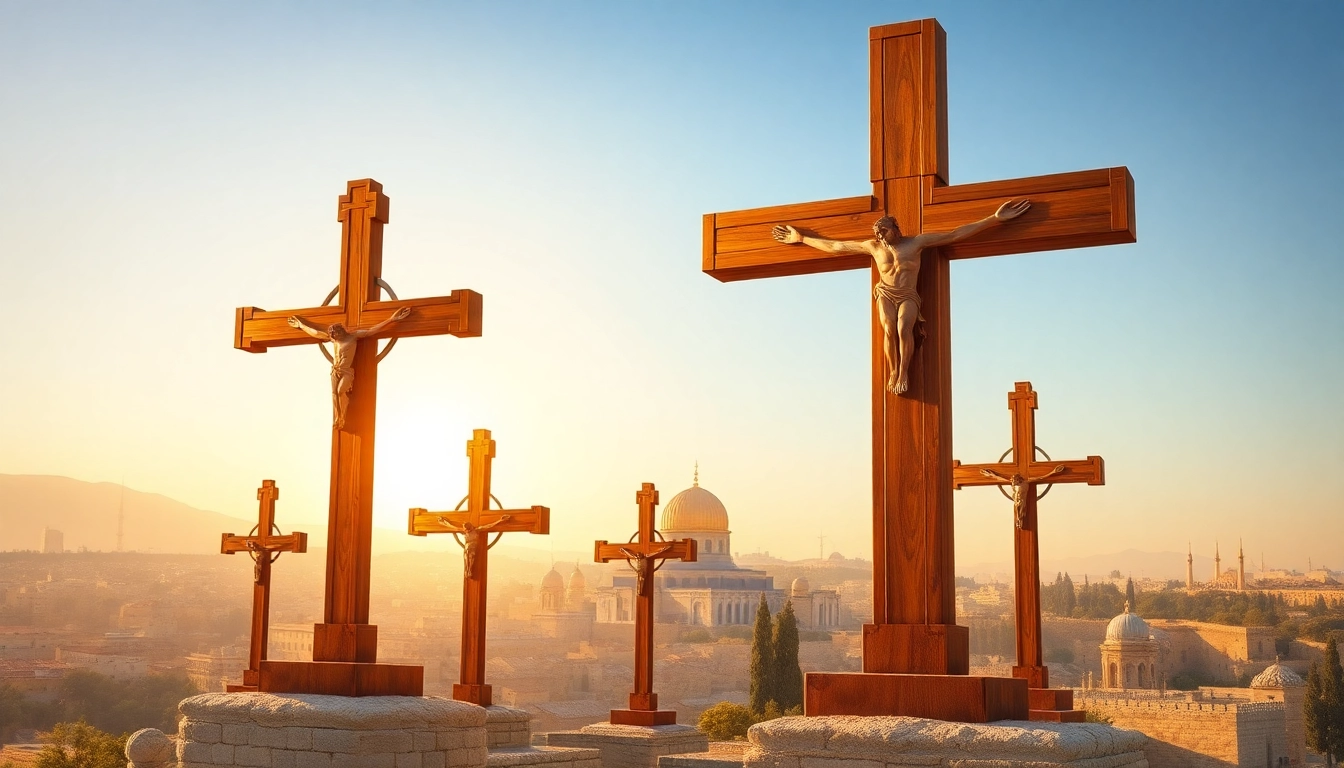Understanding Jerusalem Crosses
Definition and Origin
The Jerusalem crosses represent a notable aspect of Christian heraldry and symbolism. This unique cross design, often referred to as the “five-fold Cross” or “Crusader’s Cross,” comprises a large central cross surrounded by four smaller Greek crosses, one positioned in each quadrant. The origins of the Jerusalem cross can be traced back to the 11th century, coinciding with the establishment of the Kingdom of Jerusalem during the Crusader period. It was used as a symbol of Christian faith and identity, showcasing the convergence of artistic expression and theological significance during a tumultuous era in history.
Historical Context
To fully appreciate the significance of the Jerusalem crosses, one must consider the historical backdrop against which they emerged. The cross became a defining emblem for the Crusader Kingdom following its establishment in 1099. This was a time marked by religious fervor, military campaigns, and a quest for holy sites. The Jerusalem cross served as a rallying symbol for Christian warriors, embodying their mission to reclaim and protect sacred territories. It became an emblem of hope and victory, signifying not only the faith of Crusaders but also their aspirations for spiritual glory and territorial expansion.
Symbolism of the Cross Design
The design elements of the Jerusalem cross hold deep symbolic meaning. The large, central cross is believed to represent Christ’s sacrifice, whilst the four smaller crosses embody the Four Evangelists: Matthew, Mark, Luke, and John. This multifaceted representation illustrates the spread of the Gospel message from Jerusalem to the far corners of the Earth. Additionally, some interpretations suggest that the smaller crosses symbolize the four cardinal directions, emphasizing the universality of Christ’s teachings and the call to evangelism. Collectively, these elements underscore the profound spiritual and theological messages encapsulated within the Jerusalem cross.
Theological Implications of Jerusalem Crosses
Representation of the Four Evangelists
The association of the Jerusalem cross with the Four Evangelists highlights its theological depth. Each small cross reflects the distinctive attributes of the Evangelists, contributing to a unified narrative of Christ’s life and teachings. This representation serves as a reminder of the transformative power of faith and the pivotal role of the Gospel in Christian life. The Evangelists’ symbols are intricately linked to their narratives, informing believers about the different aspects of the same divine story and encouraging them to reflect on their faith journey.
Connection to the Gospel Spread
As a symbol of Christ’s command to spread the Gospel, the Jerusalem cross embodies the essence of evangelism. Its design serves as a visual proclamation of the Christian mission to share the Good News globally. Through centuries, the cross has inspired countless individuals and communities to engage in missionary work, emphasizing the importance of outreach and compassion in the Christian faith. The call to action represented by the Jerusalem cross demonstrates how deeply intertwined faith and mission are at the core of Christian values.
Significance in Christian Worship
In contemporary worship, the Jerusalem cross continues to hold significant meaning. It often appears in church decorations, liturgical practices, and religious artifacts. The cross serves as an object of veneration and a reminder of the sacrifice of Jesus Christ. Many parishes utilize the cross in ceremonies, such as baptisms and confirmations, reinforcing the connection to the foundational elements of faith and the wider Christian community. Furthermore, its presence in worship settings signifies not only individual devotion but also corporate identity as part of the Body of Christ.
Artistic Representations of Jerusalem Crosses
Modern Interpretations in Art
The aesthetic representation of the Jerusalem cross has evolved over time, inspiring a diverse range of artistic interpretations. From traditional paintings to contemporary sculptures, artists continue to explore this potent symbol through various media. Modern renditions often incorporate elements of abstraction, exploring themes of faith, resilience, and cultural identity. Artists utilize color, form, and texture to express the theological nuances and historical context of the Jerusalem cross, inviting viewers to engage with its deeper meanings.
Using Jerusalem Crosses in Decor
Incorporating the Jerusalem cross into home décor has gained popularity among individuals wishing to express their faith in their living spaces. Crosses can be found in various artistic forms—from wall hangings to intricate carvings made from diverse materials such as wood, metal, and glass. These decorative pieces not only serve as visual focal points but also facilitate discussions about faith, history, and culture among family and friends. The Jerusalem cross symbolizes an invitation for reflection and conversation around spiritual themes.
Craftsmanship and Materials
The craftsmanship involved in creating Jerusalem crosses highlights the dedication and skill of artisans who bring this symbol to life. Many crosses are handcrafted using traditional techniques, ensuring that each piece is unique and possesses its own story. Artisans often blend various materials, such as olive wood from the Holy Land or elegant metals, to create visually stunning pieces that honor the symbol’s rich heritage. The commitment to quality and authenticity enhances the cross’s significance as both a religious emblem and a work of art.
Jerusalem Crosses in Contemporary Culture
Symbolism in Jewelry and Fashion
The Jerusalem cross has found its way into the realms of jewelry and fashion, transcending its traditional associations to become a versatile symbol of faith and heritage. Necklaces, bracelets, and earrings featuring the Jerusalem cross cater to a growing demand for faith-based accessories that resonate personally with wearers. This trend reflects a contemporary interpretation of spiritual expression, blending style with meaning, as individuals seek to showcase their beliefs through fashion.
Use in Ceremonies and Events
The relevance of the Jerusalem cross extends into various ceremonial practices and significant life events. It is often utilized in baptisms, confirmations, weddings, and other religious milestones, serving as a powerful reminder of the divine presence in pivotal moments. Whether featured in attire, invitations, or decor, the Jerusalem cross accentuates the sacred nature of these ceremonies, drawing participants into a shared recognition of faith and community.
Public Perception and Misunderstandings
Despite its rich history and enduring significance, the Jerusalem cross has also faced misunderstandings and misinterpretations, particularly in diverse cultural contexts. Some individuals may misconstrue its association with the Crusades, viewing it through a lens of conflict rather than its roots as a symbol of faith and community. Engaging in educational efforts and open conversations can address these misconceptions, fostering a greater appreciation for the cross’s complex symbolism and historical relevance in the Christian tradition.
Conclusion: The Lasting Legacy of Jerusalem Crosses
Enduring Faith and Tradition
The Jerusalem cross will continue to embody the rich tapestry of Christian faith, history, and art. As a powerful symbol of evangelism and community, it serves as a conduit through which believers can express their spiritual identity and journey. This enduring legacy showcases the timeless appeal of the Jerusalem cross and its ability to inspire generations.
Incorporating the Cross in Daily Life
Ultimately, incorporating the Jerusalem cross into daily life encourages individuals to reflect on their faith actively. Whether through personal devotion, artistic expression, or community involvement, this symbol invites believers to live out their principles and share the love embodied in the Gospel message. The Jerusalem cross stands as both an emblem of heritage and a call to action, inspiring Christians to actively engage in their faith.
Future Relevance in Christianity
As faith communities continue to evolve, the Jerusalem cross’s relevance will persist in new and diverse contexts. The symbol has the potential to unite believers across cultures and denominations, continuing to inspire outreach, compassion, and dialogue. It remains a vital reminder of the core tenets of Christian faith: love, service, and the universality of Christ’s message. The journey of the Jerusalem cross reflects the ever-unfolding narrative of faith—a narrative that is both intensely personal and undeniably collective.



